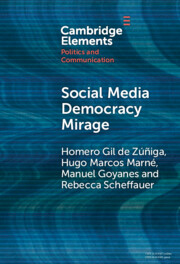Element contents
Social Media Democracy Mirage
Published online by Cambridge University Press: 20 November 2024
Summary
Keywords
- Type
- Element
- Information
- Online ISBN: 9781009053266Publisher: Cambridge University PressPrint publication: 19 December 2024
References
- 1
- Cited by

